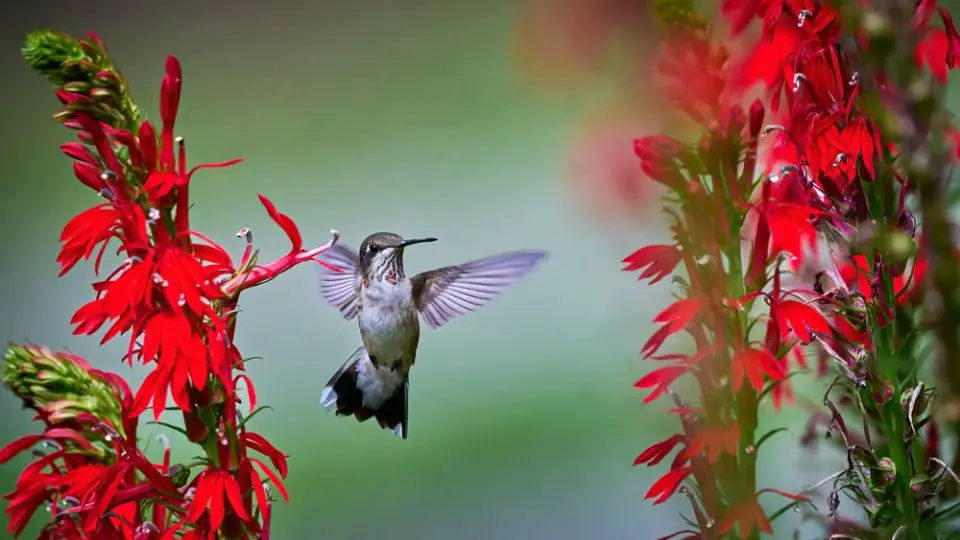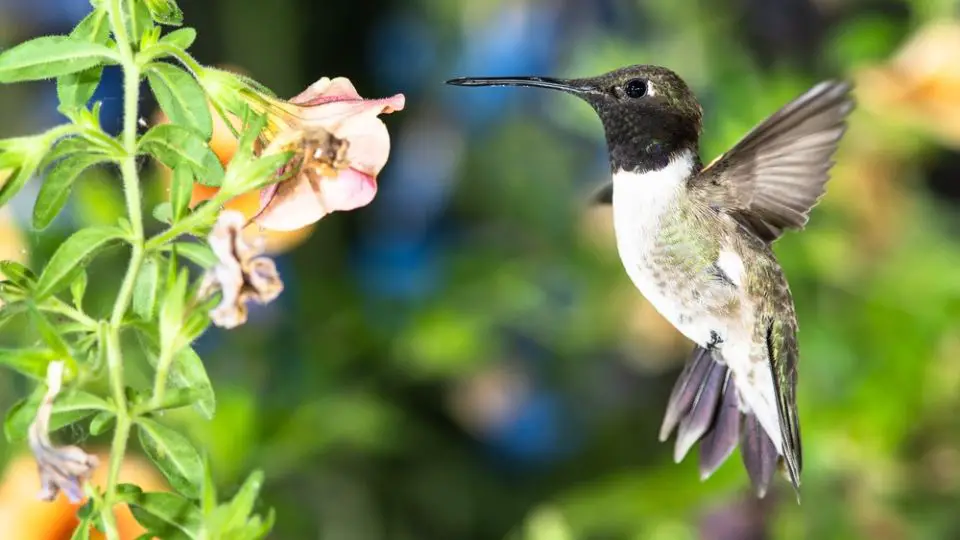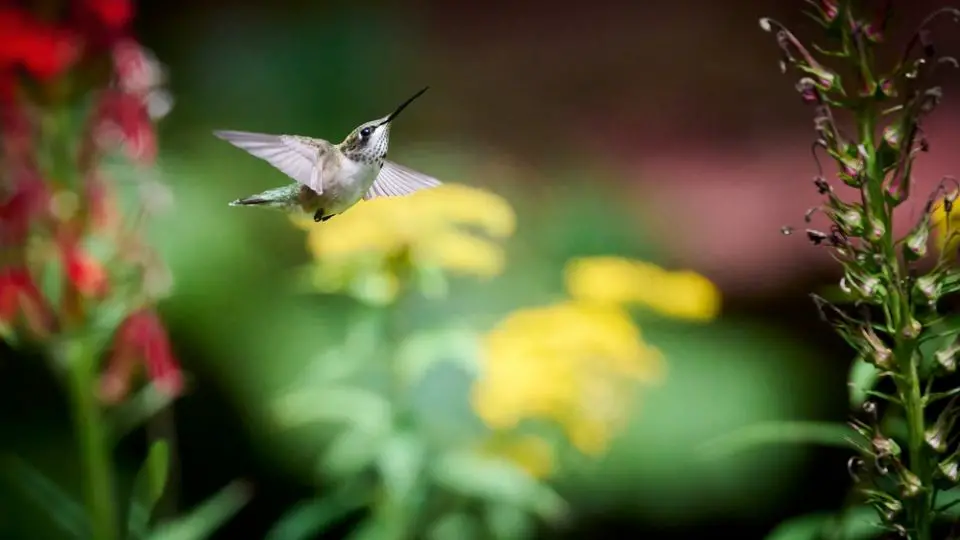Hummingbirds leave West Virginia in September, and begin to migrate south, leaving for the southern US or Mexico. Hummingbirds migrate to West Virginia by late March, arriving for breeding season. No species of hummingbirds live year-round in West Virginia.
Here, you’ll find information about hummingbirds in West Virginia—affectionately known as ‘WV.’ Learn when hummingbirds arrive in the spring. Find out when to take hummingbird feeders down in the fall, along with where West Virginia hummingbirds go in winter. Learn more about the most common hummingbird, the Ruby-throated Hummingbird.
Table of Contents
When Do Hummingbirds Migrate To West Virginia?
Hummingbirds begin to migrate through West Virginia in late March. The first hummingbirds to arrive are migrants passing through on their way to the northern US and Canada. These migrants pass through West Virginia by mid-June. The hummingbirds remaining after that point are here for breeding grounds through the summer.
Hummingbirds remember where their food sources are on their migration routes. If a hummingbird feeds from your backyard
When Do Hummingbirds Leave West Virginia?
Hummingbirds leave West Virginia beginning in September. Sightings of hummingbirds decrease, and the last hummingbirds are usually gone by mid-October. Some hummingbirds may stay in West Virginia to overwinter, but these are birds too old or injured to migrate south. Despite these stragglers remaining during the winter months, West Virginia does not have any year-round species of hummingbird.

When Should You Take Down West Virginia Hummingbird Feeders?
West Virginia residents can take down hummingbird feeders at the beginning of November. Make sure to leave feeders up until a week or two after you’ve seen the last hummingbird on your property. This ensures that all migrants have food sources on their journey south for the fall.
Hummingbird migration is signaled by changes in daylight hours and weather patterns. Leaving feeders up will not interfere with hummingbird migration patterns. It will, in fact, benefit hummingbirds during their fall migration.
Where Do West Virginia Hummingbirds Migrate?
Hummingbirds that fly through West Virginia migrate to different areas of the US, Canada, and South and Central America. Where a hummingbird migrates depends on which species it is. Allen’s Hummingbird returns to California, Oregon, and other western states. Anna’s Hummingbird doesn’t migrate, staying mainly on the Pacific Coast instead.
The Ruby-throated Hummingbird and Rufous Hummingbird inhabit Canada during the summer. In the winter, they migrate to the western US or states near the Gulf of Mexico, including Florida, Mississippi, Louisiana, Texas, and Alabama. The Ruby-throated flies as far south as Costa Rica.
What Is The Best Time Of Year To See Hummingbirds In West Virginia?
The best actual time of year to see hummingbirds is between late summer and late fall. All hummingbirds are active during this time. Male hummingbirds are gearing up for fall migration by increasing food consumption.
Females are raising their last set of young for the season, teaching the juveniles how to feed from flowers and feeders. Females also need to increase their body fat for migration. Prep your space for hummingbirds by setting out feeders filled with homemade hummingbird nectar.
Keep nectar feeders clean and filled with fresh sugar water to increase hummingbird sightings in your area. Plant red flowers or other tubular-shaped plants to attract hummingbirds. Provide a shallow bird bath, so hummingbirds always have access to water.

What type of Hummingbirds Migrate to WV?
West Virginia is the summer home of the Ruby-throated Hummingbird. Ruby-throated begin breeding in the state in June before migrating south in the fall. Four other species have been reported in West Virginia, though all these are uncommon or rare.
Ruby-throated Hummingbird
Ruby-throated are the most common species of hummingbirds reported in the summer months in West Virginia. Some arrive for breeding grounds, while others pass through on their way north to Kentucky, Michigan, Wisconsin, Maryland, or Ohio. The Ruby-throated Hummingbird is the only hummingbird with breeding grounds in the eastern US.
Some of these birds overwinter in the southern states. Male Ruby-throated get their name from the ruby-red throat, known as a gorget. Their green feathers sparkle in the sunshine, and they are often found at backyard feeders.
The females are a duller green and lack the red gorget. Some Ruby-throated may overwinter in West Virginia, as sightings of this species have been reported through January. Generally, though, Ruby-throated Hummingbirds arrive by April and begin breeding by June.
Rufous Hummingbird
Male Rufous Hummingbirds are brilliant reddish-orange, with sparkling orange gorgets. Females are a lighter orange. Though common in California, southeastern Alaska, and Oregon, this species is a rare vagrant in West Virginia.
The Rufous Hummingbird is small, around 3 inches in length. Though small, Rufous Hummingbirds are known for their aggressive behavior and are less likely to feed from hummingbird feeders. Though all hummingbirds are aggressive in defending territories, the Rufous is especially bold.
Black-chinned Hummingbird
The Black-chinned Hummingbird is an extremely rare sight in West Virginia. This species has been reported twice—in 2006 and 2015. Black-chinned typically inhabit the western US and Canada, extending from Texas through New Mexico and up to British Columbia.
This hummingbird species prefers to move to higher elevations after breeding and often perches at the top of dead trees. Male Black-chinned Hummingbirds have a black head and throat with a purple patch underneath. Females have white tips on their tails with black underneath.

Mexican violet-ear
Birdwatchers in West Virginia reported one sighting of a Mexican violet-ear in 2003. Bodies of brilliant blue and green help this species of hummingbird stand out from others. Even females have these bright colors.
Mexican violet-ears are also bigger than many other species, measuring up to 4.7 inches in length. They commonly inhabit Mexico but sometimes visit central or southern Texas. Occasionally they visit other states, but sightings outside of Texas are rare.
Broad-tailed Hummingbird
Sightings of Broad-tailed Hummingbirds in West Virginia are unconfirmed. This species is extremely rare here at best. Male Broad-tailed have a magenta gorget. Females and males have white eye rings, green feathers, and rounded tails.
Some Broad-tailed Hummingbirds migrate. These birds fly north to breed in Colorado, Arizona, Wyoming, Idaho, and Montana. Other Broad-tailed Hummingbirds remain in Mexico year-round.

